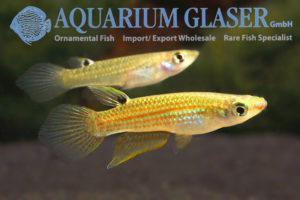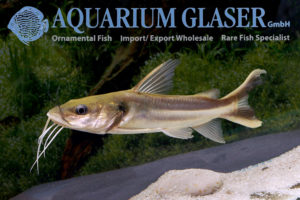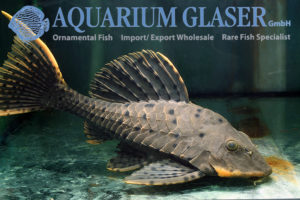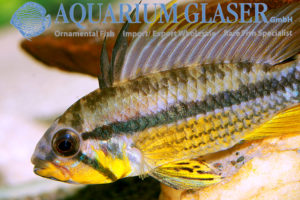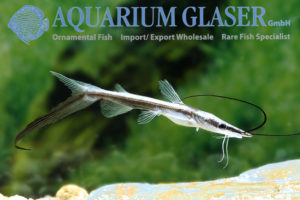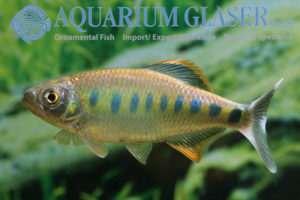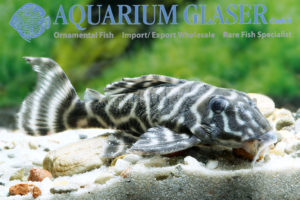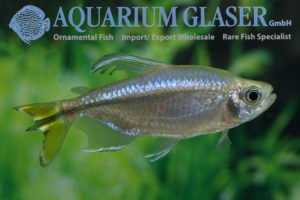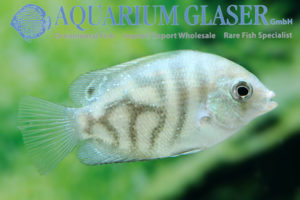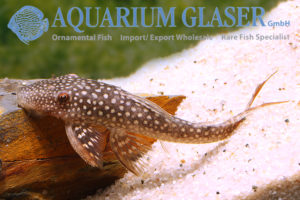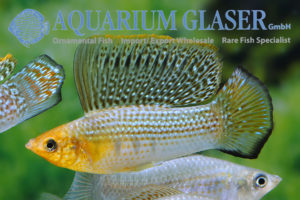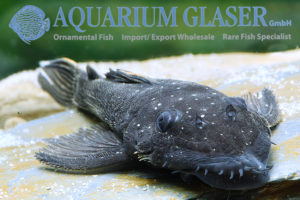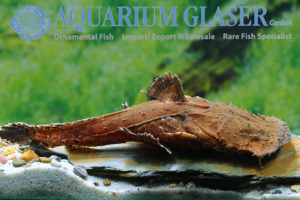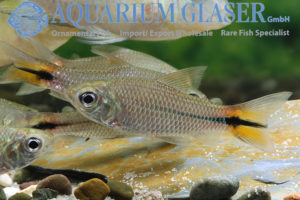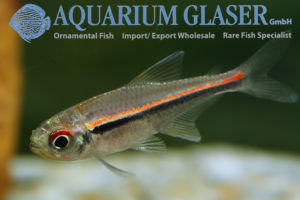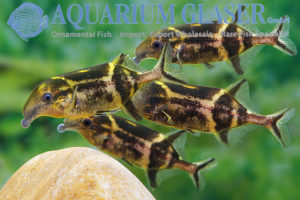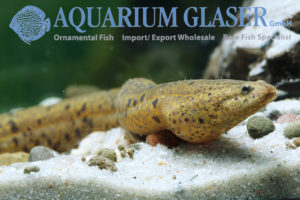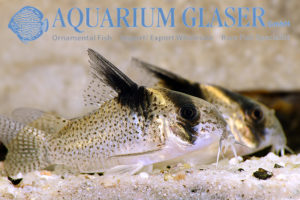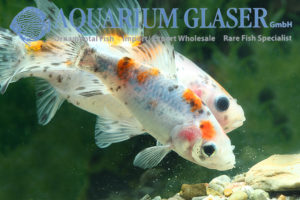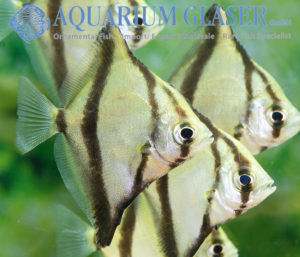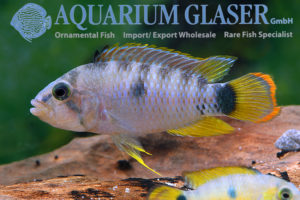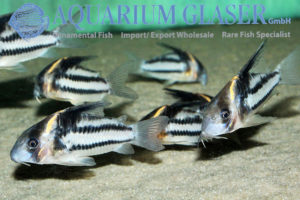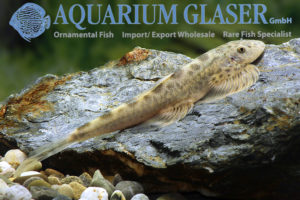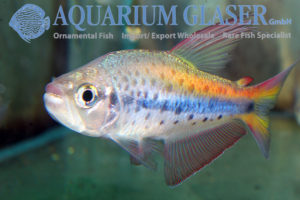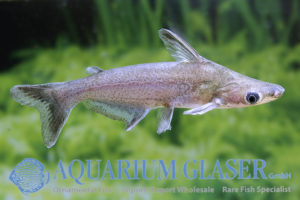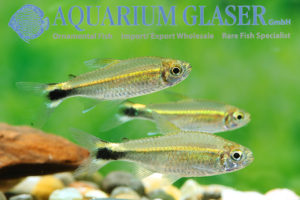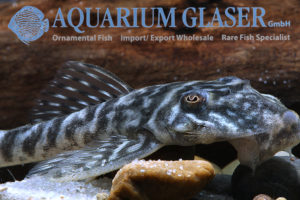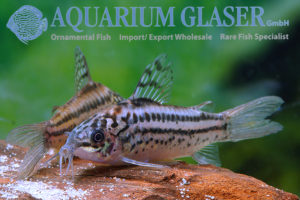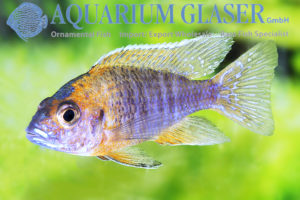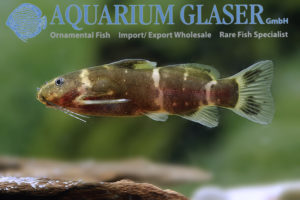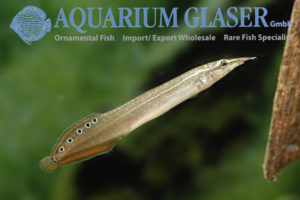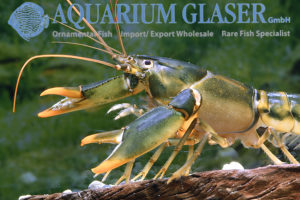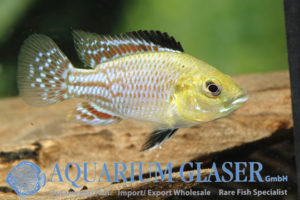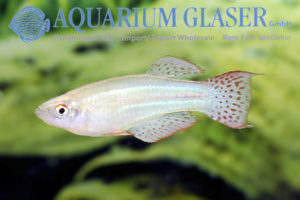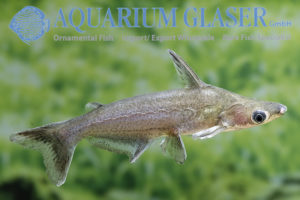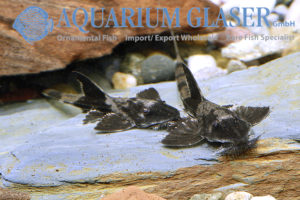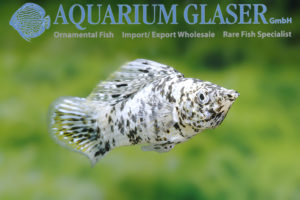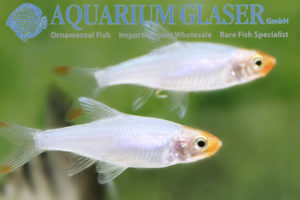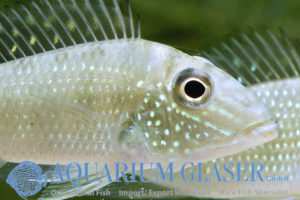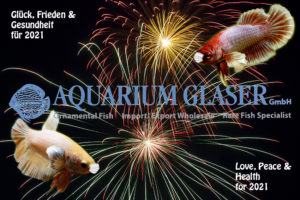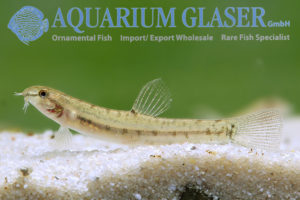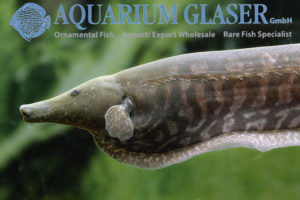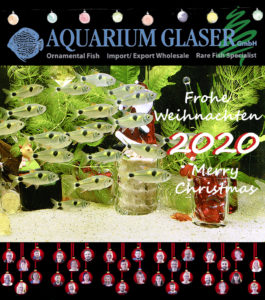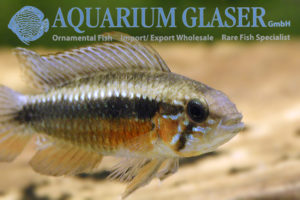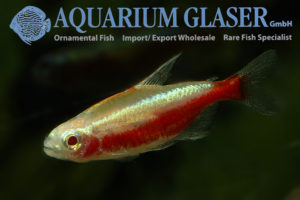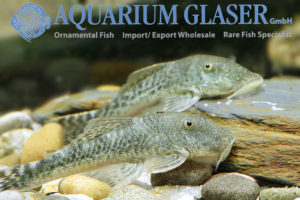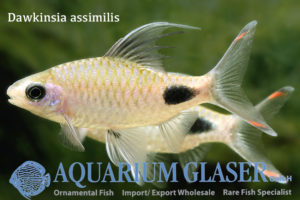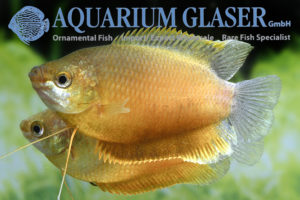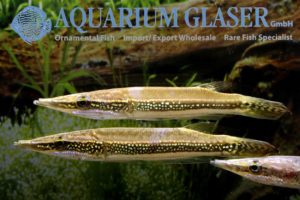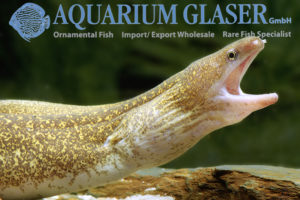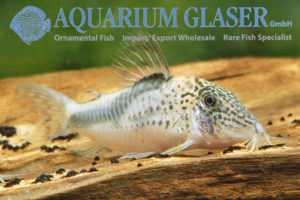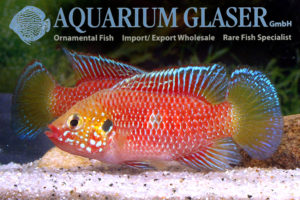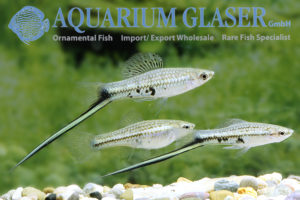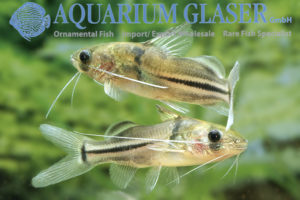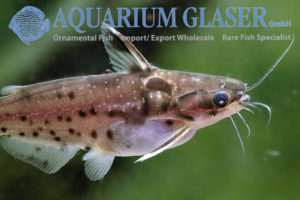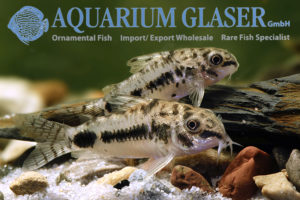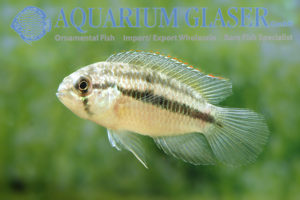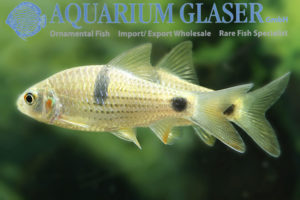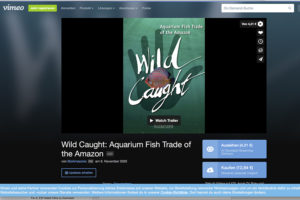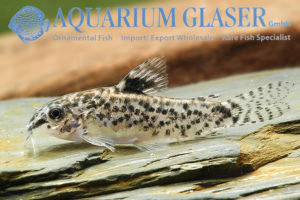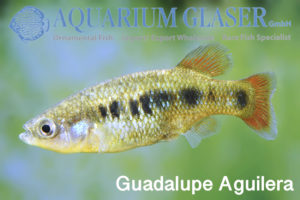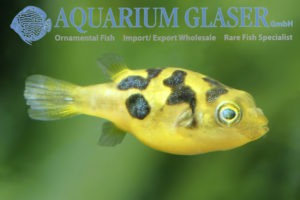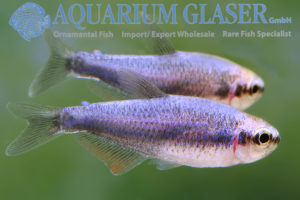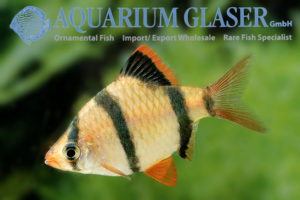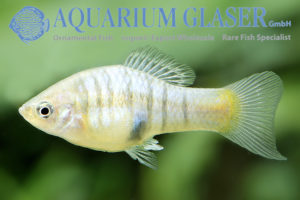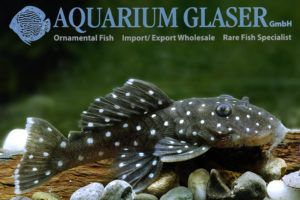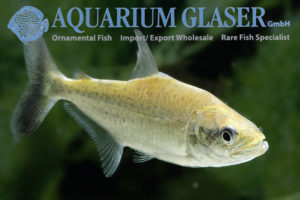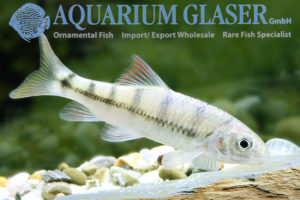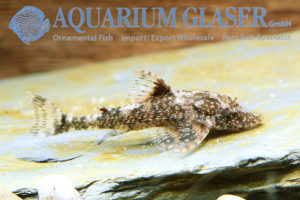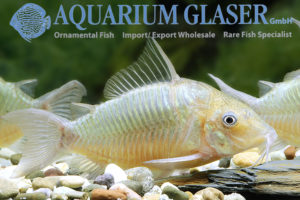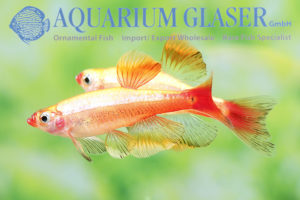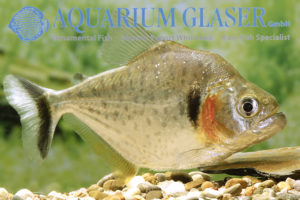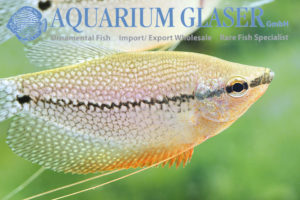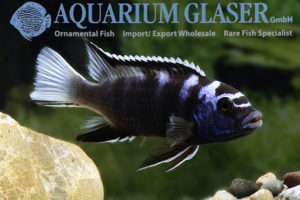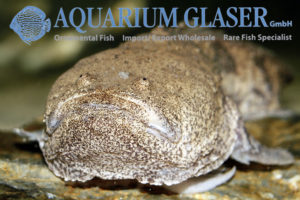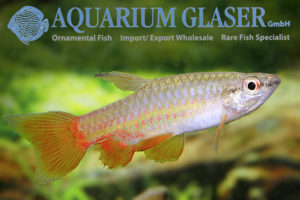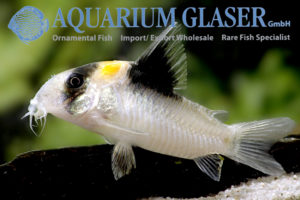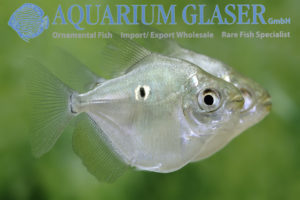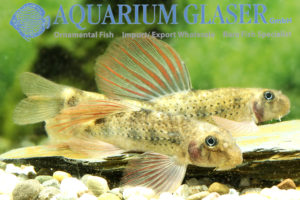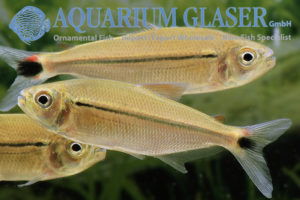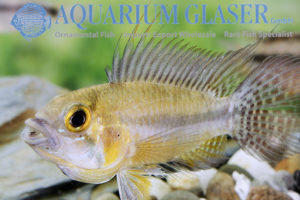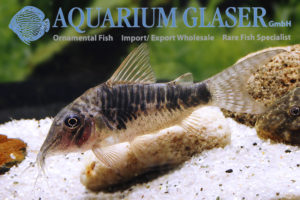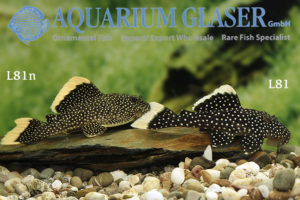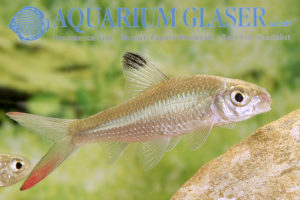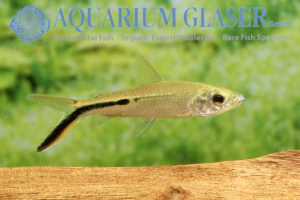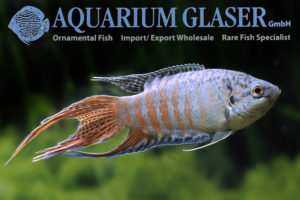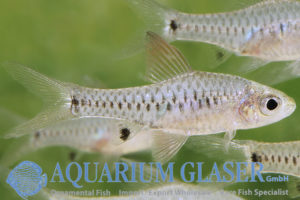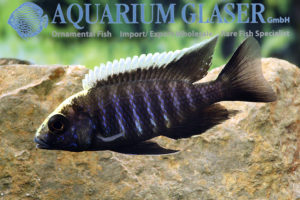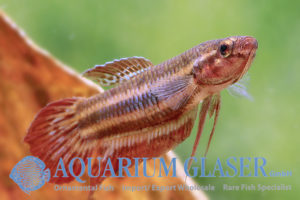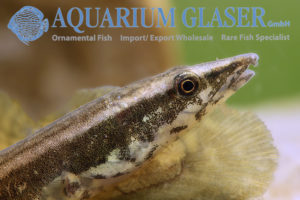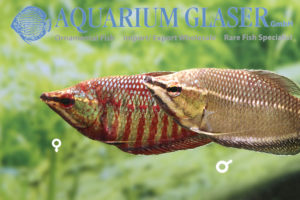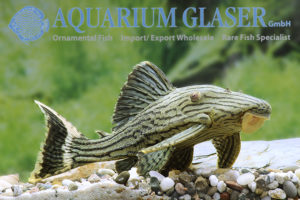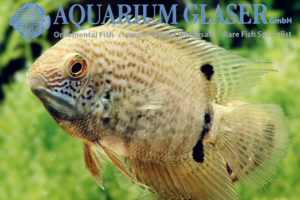The Green panchax (Aplocheilus blockii) is one of the tiniest and most beautiful species of panchax in Asia. We were able once more to import the species from Kerala (South India). Its maximum length is around 3 cm, at least as far as wild collected specimens are concerned. Aquarium specimens may become a bit larger […]
Fish Archive (3093)
-
-
Clarotes laticeps
This is one of the large river catfishes of Africa. We were able to import some specimens once more from Nigeria. However, the species has a very far distribution and is found in the Nile, most parts of West Africa and also in the rivers that flow through the savannahs and riparian forests of East […]
-
Pseudorinelepis sp. L95
Now it is again season for the unfortunately so rarely available Pseudorinelepis sp. L95 from the Rio Demini. And what beautiful animals we got! All specimens are 25-30 cm long. For more information please see https://www.aquariumglaser.de/en/fish-archives/pseudorinelepis-sp-l95-2/ For our customers: the animals have code 26480-L 095-7 on our stocklist. Please note that we supply only wholesale. […]
-
Apistogramma allpahuayo
For a long time this beautiful dwarf cichlid from the basin of the Rio Nanay in Peru sailed under the name “cf. juruensis” or “sp. Black Chin”. Only the scientific description of the species in 2012 put an end to the confusion. Great similarity exists to A. juruensis and A. cacatuoides. From both species living […]
-
Sorubim lima
The large-sized species of the spiny catfishes (Pimelodidae) belong as adult fishes to the desired food fishes and not less desired species for fans of predatory catfishes with giant aquariums. As juveniles, these animals often look completely different and have, for example, absurdly long fin processes. The Shovelnose catfishes of the genus Sorubim are with […]
-
Barilius ardens
Fishes of the genus Barilius are ecologically best compared to trout in the Indian region, where they do not naturally occur. Barilius thus prefer to live in clear waters with a gravelly bottom and some current. They are mostly seen in loose groups, they are not really schooling fish. They like to “play” among themselves, […]
-
Hypancistrus sp. “Nhamunda” L475
The Hypancistrus catfishes with striped pattern are on the one hand a wonderful enrichment for the aquaristics, because they look beautiful, don’t grow too big and can be bred quite well, on the other hand they are constant cause for quarrel. Because in many cases it is hardly possible to determine them exactly. This is […]
-
Alestopetersius caudalis
The Yellow Congo Tetra (Alestopetersius caudalis) originates, as the name suggests, from the Congo. However, it is almost never traded as wild catch, because it can be bred very well. With a final length of about 6 cm it belongs to the smaller species of the Congo tetra relationship. In the course of its aquaristic […]
-
Etroplus suratensis Bred
Mostly we receive the Indian Pearl Cichlid (Etroplus suratensis) as wild catch from South India (formerly also from Sri Lanka) or as German offspring from zoo aquariums. Now, for the first time, we have imported bred ones from Indonesia; some specimens of these offspring do not show a stripe pattern, but have an irregular bow […]
-
Lasiancistrus heteracanthus
We were able to import the rare Red-eyed Deltatail-suckercat, Lasiancistrus heteracanthus, in small numbers from Peru. The species attains a total length of 15-18 cm. Besides the bright red eye the most striking feature of the species is the pretty brown-red lower lappet of the caudal fin. Lasiancistrus, in general, are good algae-eaters and fit […]
-
Poecilia velifera Green
From the sailfin molly, Poecilia velifera, which originates in the hot coastal regions of Mexico, there are mostly cultivated forms in the trade: Golden, chocolate, leopard, dalmatian, black, etc.. The “green” wild form is much rarer, although they are very colorful animals. All sailfin mollies on the market are bred ones. The huge dorsal fin […]
-
Ancistrus macrophthalmus LDA74
From time to time we receive a very flat-bodied Ancistrus from the Orinoco drainage in Colombia and Venezuela under the name of A. ranunculus/L 34. However, this species does not exist there, A. ranunculus is only known from the Amazon tributaries Xingu and Tocantins/Araguaia; the Orinoco species is Ancistrus macrophthalmus, which has received the LDA […]
-
Chaca bankanensis “Sumatra”
This week we received a good number of the interesting frogmouth catfishes of the species Chaca bankanensis from Sumatra. In contrast to the rather reddish animals we could import earlier (https://www.aquariumglaser.de/en/fish-archives/chaca_bankanensis_en/), this time they are rather brown-black colored, probably an origin-related color characteristic. Very interesting is that some animals have striking white colored eyes. At […]
-
Curimatopsis macrolepis
The genus Curimatopsis comprised five described species until 2009 – now (2021) there are more than twice as many, namely 11! Curimatopsis can be divided into two major groups. First the C. macrolepis group with 6 species and second the C. evelynae group with 5 species. The best distinguishing feature of the two groups is […]
-
Hyphessobrycon heterorhabdus
Already in 1894 the three-banded flag tetra (Hyphessobrycon heterorhabdus) was described scientifically; the animals on which the description was based came from the Brazilian state of Pará, more detailed information or illustrations are not available. From 1910 and in the 1920s, when the tetras advanced to the most popular aquarium fishes, also three-banded tetras came […]
-
Campylomormyrus tamandua BRED
Elephant fishes or mormyrids are very interesting and also entertaining fish. They communicate among themselves with electrical signals and have – similar to birds – a relatively well developed cerebellum. Their bizzare body shape makes them additionally interesting. However, they have little to offer in terms of color, mostly coming along in shades of brown […]
-
Synbranchus marmoratus
Only very rarely marbled swamp eels from South America are available. After a quite long time we now have a number of juveniles from Peru in stock. The species attains a maximum length of about 1.5 m. These very large individuals are always males, because swamp eels change their sex. Most of them are born […]
-
Corydoras sp CW 98
This beautiful Corydoras belongs to a scientifically undescribed species. It originates from the upper Rio Negro in Brazil. Because of the bright orange neck spot it is usually misidentified as Corydoras burgessi, which also comes from this region, especially as C. burgessi has a very variable pattern and there are also spotted colour variants of […]
-
Shubunkin
It is and remains the oldest ornamental fish in the world: the goldfish (Carassius auratus) and its many cultivated forms. It has been propagated and kept by humans for about 1,000 years. Many consider goldfish to be garden pond fish, especially the varieties with “nomal”, wild fish-like body types. This is quite true, and they […]
-
Monodactylus sebae
The African Mono is widely distributed along the tropical Atlantic coast of Africa. As a completely euryhaline fish, it can freely change between fresh, brackish and seawater; it prefers to stay in brackish water. In its native range M. sebae is a common fish and is caught there for food. In the past, aquaristic needs […]
-
Apistogramma sp. Oregon
The attractive Apistogramma sp. Oregon comes from the wider surroundings of Iquitos in Peru. Don’t ask us why this one is called “Oregon” – we don’t know that either. It belongs to the closer relationship of A. nijsseni, but differs clearly from this species by the bulky body structure, the large tail spot and a […]
-
Corydoras sp. aff. parallelus CW127
Just as L-numbers are assigned for undetermined loricariids, C- and CW-numbers are assigned for undetermined Corydoras. One of the first species to receive such a number was Corydoras parallelus, which was assigned the number C2 in 1993. In the same year Burgess described it as C. parallelus. The species originates from the upper Rio Negro […]
-
Hemimyzon nanensis
With the import of Hemimyzon nanensis we were once again able to fill a white spot on the map of fishes that have become known in the aquarium with content. At least for us it is a first import. Hemimyzon belongs to the family of hillstream loaches (Balitoridae) and is closely related to the genus […]
-
Pseudochalceus kyburzi
In our last post on this impressive and beautiful tetra species from Colombia, we wrote “This tetra usually grows to around 5 cm long, with 8 cm given as the maximum size.” (https://www.aquariumglaser.de/en/fish-archives/pseudochalceus-kyburzi-4/). Since last week we know, this maximum size can actually be reached! Wow, that’s the first thing we thought of these huge […]
-
Tympanopleura cryptica
For the first time we could (recognized) import this dolphin catfish from Peru. The small species (the biggest scientifically known animal had a standard-length – therefore without tail fin – of barely 8,5 cm) occurs in the area of the upper Amazon, where the river is still called Solimoes. Tympanopleura cryptica was described scientifically only […]
-
Hemigrammus hyanuary Wild
In 1957, when the first Green Tetras or Neon Costello (Hemigrammus hyanuary) were imported, the tetras were absolute fashion fish. Otherwise the comparison with the neon or cardinal tetra can hardly be explained, because H. hyanuary – which by the way is named after Lake Hyanuary in Brazil – is really nicely colored, but it […]
-
Pseudolithoxus kelsorum L189
Unfortunately this interesting catfish from Venezuela is offered only very rarely. It lives in the tributaries of the middle Orinoco. With a maximum length of 10 cm (only very rarely some specimens reach this size, the normal size is 6-7 cm) the species remains relatively small. Pseudolithoxus species are all quite flat, but P. kelsorum […]
-
Corydoras elegans
The armored catfishes of the closer relationship around Corydoras elegans belong to the most interesting species of this huge genus. They do not live as strongly bottom-bound as most other armored catfishes and are very nicely colored. Males and females differ relatively clearly in coloration. However, it is not easy to provide a color description […]
-
Aulonocara “Rubescens”
Do you know the game “Silent Mail”? You play it with at least 10 participants, the more, the better. One of the players thinks up a term and whispers it – inaudible to the others – into the ear of the player next to him. This whispers what he has understood to the next one, […]
-
Microsynodontis batesii
Squeakers or upside-down catfishes are a fish family occurring exclusively in Africa. The best known genus is Synodontis, which comprises over 130 species. Closely related to this genus is the genus Microsynodontis. The genus name means “small Synodontis” and is program, because these fish already become sexually mature with 3-4 cm of length, are thus […]
-
Macrognathus siamensis Red Tail
At the moment we can once again offer very beautiful – i.e. strongly colored – offsprings of a dwarf spiny eel, which is not yet precisely identified. It is offered under the name Macrognathus aculeatus, but for various reasons it will probably not be this species. It shows the most similarity to Macrognathus siamensis, because […]
-
Cherax snowden
The diversity of the crayfishes of New Guinea is hard to keep track of. Most difficult is the decision, whether a freshly imported form is a color variant of a long known species or a new species; because the color variance within the species is enormous. Cherax snowden was known as Cherax sp. “Orange Tip” […]
-
Pseudocrenilabrus nicholsi
This dwarf mouth-breeder comes from the middle and upper Congo, from where ornamental-fish-imports almost never reach us. Pseudocrenilabrus nicholsi is therefore only available as bred ones. The males are beautiful, the females are rather plain colored. The maximum length is about 7 cm, but also this size is reached rather rarely; the photographed, sexually mature […]
-
Procatopus aberrans
We obtained very nice Procatopus aberrans from Nigeria. These lampeyes are very peaceful schooling fish that live near the water surface or at least in the upper third of the water column. In contrast to most other species of lampeye that have an iridescent blue zone in the iris, in P. aberrans the iridescent zone […]
-
Tympanopleura cryptica
For the first time we could (recognized) import this dolphin catfish from Peru. The small species (the biggest scientifically known animal had a standard-length – therefore without tail fin – of barely 8,5 cm) occurs in the area of the upper Amazon, where the river is still called Solimoes. Tympanopleura cryptica was described scientifically only […]
-
Lorcaria simillima Bred
Loricaria simillima has a very wide distribution in South America. It is found in the Orinoco-, Amazon- and La Plata basins. A result of this large area many different color forms are known, which differ clearly regarding coloration and pattern. The species occurs in different water types. Black water forms are more demanding in maintenance […]
-
Poecilia velifera “Dalmatiner”
At least three species of mollies are the parent species of the numerous breeding forms that exist of these fish today: Poecilia sphenops, P. latipinna, and P. velifera. Possibly P. mexicana was also involved, but this is unclear, as this species was long considered a synonym of P. sphenops. Some color and fin characteristics could […]
-
Sawbwa resplendens
Lake Inle in Burma is a mountain lake located on the Shan Plateau about 900 meters above sea level; it is about 65 km long and 10-22 km wide. The water is relatively hard (12-17° GH) and in February the water temperatures drop to 14-18°C. Lake Inke is world-famous for its human inhabitants, whose entire […]
-
Satanoperca sp. aff. jurupari “Tapajos”
Some of the earth-eaters of the genus Satanoperca have frightening names (Satanoperca = devil-perch, Jurupari = devil, Daemon = demon, Lilith = the bride of the devil), but there are only few cichlids that are as peaceful and harmless as they are. The most important thing they need in an aquarium is a part of […]
-
A perfect start
and a happy, successful and healthy New Year 2021 wishes you the whole team of Aquarium Glaser
-
Lepidocephalichthys kranos
For the first time we can offer these cute dwarf spined loach from Vietnam. They become (without caudal fin) at most 3,5 cm long. Lepidocephalichthys kranos was not recognized as an independent species until 2010. The species differences in Lepidocephalichthys are very subtle (otherwise they would have been scientifically identified earlier), but it is quite […]
-
Rhamphichthys rostratus
Since some time we can offer a very interesting knife-fish species of the genus Rhamphichthys, which we receive as offspring from Indonesia. Rhamphichthys are attractive fish, but they require strong nerves from their keeper, because they rest lying on their side and look like dead at first sight. But they are very happy, only sleeping. […]
-
Exodon paradoxus
For many aquaristis the Bucktooth tetra, Exodon paradoxus, is simply the most beautiful tetra from South America. The splendid fish glitter and glimmer like diamonds and they never stay still. They hunt and hit their conspecifics permanently and an uneducated watcher may become quite concerned that the fish will eventually hurt each other. But this […]
-
Apistogramma elizabethae
This wonderful dwarf cichlid belongs to the rarest and most wanted species of Apistogramma in the trade. Nevertheless the animals are not very difficult to keep at all. If the fish is kept under the correct conditions it belongs to the hardier species of the genus. There do exist elder reports on the fish that […]
-
Paracheirodon axelrodi “Gold”
The cardinal tetra, Paracheirodon axelrodi, is one of the most traded ornamental fish worldwide. It is a big exception in the ornamental fish trade, because it was mainly traded as a wild catch; it is different with almost all other important ornamental fishes, which are mainly or exclusively traded as bred ones. It is said […]
-
Chaetostoma joropo (L445)
The dotted Chaetostoma joropo is already for many years a popular sucker-catfish. Before its scientific description in the year 2016 it was given several names, e.g. sp. Spotted, cf. milesi, Villavicencio I, L187a etc. It originates from creeks in the catchment area of the Rio Meta in Colombia and therefore does not need to be […]
-
Dawkinsia assimilis
The so-called filament barbs of the genus Dawkinsia were assigned earlier all together to the types Barbus or Puntius. They received the popular name because the back-fin of the males with its long fin-rays. The differentiation of the species is extraordinarily tricky, although several scientists tried in the last decades at them. Only a few […]
-
Colisa labiosa “Orange”
The identity of Colisa labiosa, a gourami from Burma, is unclear; there is some evidence that the species so named in the hobby is actually not identical with C. labiosa in the sense of the first describer (Day, 1877), but it is much more likely that it is a scientifically not yet named species. But […]
-
Luciocephalus aura
The pikeheads (Luciocephalus) are highly specialized labyrinth fish. They live as predators in blackwaters of Southeast Asia. Only two species are known, the “common” pikehead, which occurs on the Malay Peninsula and in Indonesia, and the Peppermint Pikehead, which is known so far only from the Province Jambi on Sumatra. Currently we are able to […]
-
Gymnothorax tile
For many years the up to 60 cm long moray eel species Gymnothorax tile has been sold as “freshwater moray”. It is true that G. tile can live in pure fresh water for a while (a few months) without showing any discomfort. But practice shows that this moray eel species is much more persistent in […]
-
Corydoras fowleri German bred
Corydoras fowleri from Peru becomes 6-8 cm long and certainly belongs to the most beautiful Corydoras at all. Nevertheless, the species is only rarely bred, because the eggs are relatively small and the fish – despite their size – relatively unproductive. Therefore we are especially pleased to be able to offer wonderful German bred ones […]
-
Hemichromis sp. Red Gabon
Red Jewel Cichlids are gorgeous fishes. Their splendid coloration can be hardly topped. And they have a fascinating behaviour. They form a biparental family, both male and female take carefor the offspring together. No real hobbyist can hestitate to be banned by that look. The only negative aspect of these fishes is: they can be […]
-
Xiphophorus montezumae
With the swordtails (Xiphophorus), the males carry a sword-like extension at the low end of the tail fin in many species. This is a luxury structure, that serves the intraspecific communication. Sword-bearing males appear especially sexy on the females and especially intimidating on male conspecifics. The also with primates (the ape-like animals) well known game […]
-
Brachyrhamdia meesi
The genus Brachyrhamdia includes only five described species, another one, that is still scientifically undescribed, was imported over 10 years ago as accidental catch, since then, one heard nothing more of it. Brachyrhamdia are relatively small-growing catfish. Brachyrhamdia meesi comes from Brazil and grows to about 8 cm in length. Like all species of the […]
-
Auchenipterichthys punctatus
It was believed for quite a long time that the genus Auchipterichthys would contain only one or two, very far spread species. In 2005 Ferraris, Vari, and Raredon revised the genus and could show that in reality four different species are involved. The species that was thought so far to be the most common in […]
-
Corydoras habrosus
Now it is season for the cute chessboard dwarf cory, Corydoras habrosus. The fish grows to a maximum of four centimeters. It is completely peaceful and leaves the plants in peace, so it is very suitable for community aquariums. The usual care-recommendations for Coryoras are valid, which means they should be kept in groups and […]
-
Nannacara sp. “Crique Canceler”
The Goldeneye cichlid (Nannacara anomala) is a classic among aquarium fish. Already 80 years ago this species taught the aquarists what emancipation means, because here the female is the absolutely dominant fish. And the female often is only half as big as the maximum 8 cm long male. Dwarf cichlids from the closer relationship of […]
-
Systomus binduchitra
For the first time we could import this beautiful barb from Burma. The largest scientifically known specimen of Systomus binduchitra (the species name comes from Sanskrit and means “spotted”) was 8 cm long including tail fin. Due to its close relationship to S. sarana, it can be assumed that it will probably grow somewhat larger […]
-
Complete documentation about the advantages of the wild caught ornamental fish in Amazonia now available
Again and again it is circulated that the wild caught of ornamental fish threatens species and the diversity of species, is predatory exploitation of nature. However, there are no scientific studies that would prove this. All scientifically founded, serious work on the topic proves the opposite: Wild caught of ornamental fish is a clean thing! […]
-
Aspidoras pauciradiatus
This cute dwarf armored catfish reaches a maximum length of only 3 cm. Aspidoras pauciradiatus comes from the central Rio-Negro area and is an ideal community fish for characins, dwarf cichlids etc. Strangely enough, the specimens on which the scientific description is based were allegedly collected in the Rio Araguaia near the town of Aruana, […]
-
Characodon audax Puente Pino Suarez and Guadalupe Aguilera
Several goodeids are a parade play for the fact that conservation of species in captivity by hobby aquarists is possible and partially extraordinarily successful. The species Charcodon audax occurs endemically (i.e. exclusively there) in parts of the catchment area of the headwaters of the Rio Mezquital in the Mexican state of Durango. It is threatened […]
-
Carinotetraodon travancoricus
The first Indian dwarf puffer fish (Carinotetraodon travancoricus) of the new season have arrived. These cute animals – they are freshwater puffers – only grow 2-3 cm long in nature, in the aquarium they may grow a little bigger, but not much. You should keep these animals in a swarm if possible; then they form […]
-
Inpaichthys kerri “Super Blue”
There is a nice story about the discovery of the king tetra, which we don’t know if it’s true, but it’s worth telling: In the Instituto Nacional de Pesquisas da Amazônia (INPA), Manaus, Brazil, aquatic plants were kept in an aquarium. Fish were actually not in it. But suddenly, as if from nowhere, cute baby […]
-
Puntigrus anchisporus – tiger barb
No other classic aquarium fish has had to put up with such a drastic renaming regarding the scientific name as the tiger barb. This is due to the fact that in earlier decades, characteristics that we now consider important species characteristics were only considered an unimportant variance. The actual tiger barb, Puntigrus tetrazona, which comes […]
-
Xiphophorus xiphidium
The sword platy, Xiphophorus xiphidium, belongs to the top rarities among the live-bearers. The species is found on the headwaters of the Soto La Marina River and its tributaries, Tamaulipas State, on the Atlantic side of Mexico. The very pretty species remains with approx. 3 cm (male) resp. 4 cm (female) clearly smaller than the […]
-
Parancistrus nudiventris, L31, LDA4, Peppermint Pleco
This pleco from the Rio Xingu is an old friend, however, it received a scientific name only in 2005. It received the L-number 31 already in 1989. The genus Parancistrus is closely related to the genus Spectracanthicus; the formerly often used genus Oligancistrus is invalid and declared synonymous with Spectracanthicus. The only difference between Parancistrus […]
-
Serrasalmus elongatus
This very elongated Piranha can be confused hardly with other species because of its characteristic body shape. Type locality is the Rio Guaporé, Mato Grosso, Brazil. Aquaristic imports are mostly from Peru. Serrasalmus pingke from Venezuela was described from the Rio Apure. The holotype (54 mm long) is shown in MACHADO-ALLISON (2002); it has a […]
-
Acrossocheilus paradoxus
Only rarely does the pretty barbel Acrossocheilus paradoxus reach us, which is native to China and Taiwan. It is a medium sized species; in the wild you usually find specimens up to 12 cm total length, but the record for this species is 22.5 cm. Such large animals look different, the head is longer and […]
-
Parotocinclus eppleyi
One of the smallest loricariid species at all is Parotocinclus eppleyi, the Peppermint-Oto. The species is fully grown with a length of 3 cm (without caudal fin), but such animals can already be seen as xxl-format and are extremely rare. Usually the species, which is common in the upper and middle Orinoco, is 0.5-1 cm […]
-
Brochis splendens “Rio Negro
Via Manaus we have been able to import splendid Brochis splendens. The Emerald Cat comes from a huge area, from Peru to the Pantanal in Brazil; based on the experience with other Corydoras it is more than likely that there are several species hiding behind the name “Brochis splendens”. But such things should be subject […]
-
Tanichthys “Gold Longfin“
Since its first import in the 1930er years, the White Cloud Mountain minnow (Tanichthys albonubes) is available practically exclusively as offspring for the aquarium hobby. Nowadays, this is all the more true since the free-living stocks are considered highly endangered due to environmental pollution. However, the “simple” white cloud is not really bred by most […]
-
Serrasalmus humeralis
The identification of many Piranha species is difficult. One of the earliest described piranha species and therefore with many taxonomic problems is Serrasalmus humeralis. Valenciennes was the first descriptor in 1850, but there is no question that he had received the type specimen, for which he states “Amazon” as the type locality, from Castelnau. In […]
-
Trichogaster leerii WILD – Borneo
The pearl gourami (Trichogaster leerii, Trichopodus leerii) is one of the most popular aquarium fishes at all. It is probably not exaggerated if one assumes millions of individuals in aquariums all over the world. All these fish are bred ones. It is only little known that the pearl gourami belongs to the endangered species as […]
-
Pseudotropheus sp. “Acei” White Tail Ngara
Where does a species start, where does the location variant end? This question is really difficult to answer for some groups of fish, e.g. killies and cichlids from Lake Malawi and Lake Tanganyika. In the case of Pseudotropheus sp. “Acei” from Lake Malawi, the species is not described scientifically. Mostly the light blue, yellow-fin “Acei” […]
-
Thalassophryne amazonica
The toadfishes a very odd creatures. A total of about 73 species exists which are placed in around 22 genera and three subfamilies. One of these subfamilies – the Thalassophryninae – is also known as the “venomous toadfishes”. Thalassophryne amazonica, one of the very few freshwater species of the family, is placed in that subfamily. […]
-
Pyrrhulina brevis
The characins of the genus Pyrrhulina can be better compared to cichlids than to other characins in terms of their behavior. The males occupy small territories in the breeding season, color themselves splendidly and defend the spawn energetically until the young hatch. The generic name Pyrrhulina means “small bullfinch” because the males of many species […]
-
Corydoras burgessi
Now the season for the very beautiful and much beloved orange blotch corys has started. There does exist a good number of different species and varieties, all have in common a brightly shining spot on the neck. Depending on light this glows from yellow to almosr red. This glowing spot helps the fish in the […]
-
Mylossoma aureum
The magnificent pacus of the genus Mylossoma that reach at most approximately 30 cm of length (the average length in the nature amounts to approximately half of this measure), are only with difficulty determinable. The last revision from 2018 (Mateussi et al.) distinguishes 4 species south of the Andes (another species, M. acanthogaster, occurs in […]
-
Microphysogobio tafangensis
The genus Microphysogobio comprises more than 30 species of small (6-10 cm) gudgeons. Many species look very similar to each other and for many of them it became clear only by molecular examinations (DNA) that the comparatively small differences are in fact species differences. Aquaristically, these animals, which usually colonize fast-flowing, cool waters in nature, […]
-
Jupiaba sp. „Cherry Spot“
Once more we were able to import a new species of tetra from Venezuela which does not resemble to any species known to us. According to the supplier the animals were collected in small brooks in the surroundings of Puerto Inirida. There are no doubts that our new imports belong to the Astyanax relationship in […]
-
Apistogramma cacatuoides Yellow wild
The Cockatoo Dwarf Cichlid is one of the most popular members of the genus Apistogramma and found in petshops all over the World. Almost exclusively bred specimens of very colourful sports are traded. These do not appear in the wild. However, “the” wild form of A. cacatuoides does not exist at all. Like so many […]
-
Corydoras sp. Souza, C124
We received very nice, fully grown specimens of this only very rarely available species from Peru. This species of Corydoras is very variable in respect of the pattern. However, we think the darkest animals are the males. For our customers: the fish have code 225215 on our stocklist. Please note that we exclusively supply the […]
-
Baryancistrus xanthellus L18, L81, L81n, L177
About from the end of May to the end of September the season of the beautiful Golden Nuggets of the genus Baryancistrus lasts. Although the fish are considered to be extremely common in nature, are also found in shallow water and have been used as food fish since time immemorial, they were only scientifically described […]
-
Discherodontus ashmeadi
The redtail barb Discherodontus ashmeadi originates from the tropical Southeast Asia. It can reach an overall length of up to 14 cm. They occur widespread in the Mekong and Meklong areas. In their appearance especially the dark dorsal fin spot and the strong red markings of the caudal fin stand out. In their native country […]
-
Anodus orinocensis
From Venezuela we could import Anodus orinocensis for the first time. As a young fish A. orinocensis often lives in mixed shoals with Hemiodus gracilis. The two species really look amazingly similar, but Anodus is a Aufwuchs eater, and also filters the water for small organisms and swims mostly in “normal” horizontal swimming position, while […]
-
Macropodus opercularis “Blue“
There are no blue paradise fish in nature, they are a cultivated form with a blue back (vs. red-brown in the wild form). When exactly and in whom the first blue paradise fish appeared is not documented. It must have been in the late 1940s or early 1950s, because from then on they were mentioned […]
-
Oreichthys parvus
Unfortunately, Roloff’s Pygmy Barb – the popular name dates back to the 1950s and refers to the synonym Puntius roloffi – very rarely finds its way into our aquariums. The cute animal grows only about 3 cm long and its appearance is somewhat reminiscent of the Checkered barb, Oliotius oligolepis (formerly: Puntius o.). In contrast […]
-
Aulonocara maylandi
The sulphur head aulonocara, Aulonocara maylandi, is one of the most peaceful species of Malawi cichlids. The species reaches a maximum length of 12 cm (male) and 10 cm (female). In the wild these fish only live in two reefs of the south-eastern Lake Malawi, namely Chimwalani Reef (formerly Eccles Reef) and Luwala Reef (formerly […]
-
Betta coccina
Right now we have especially large and beautiful Betta coccina from Indonesia in stock. As the pictures show, this time the males have particularly extensive blue patches on their flanks; the females of Betta coccina generally do not have blue flank scales. Betta coccina can be kept well in groups, but even these comparatively peaceful […]
-
Sinobdella sinensis
For the first time we have obtained this highly interesting, small spiny eel. The species rarely grows larger than 20 cm and inhabits China and parts of Vietnam. According to its origin, care in unheated aquariums is recommended. In Sinobdella the dorsal, caudal and anal fins are fused together, in Asian spiny eels this is […]
-
Sphaerichthys vaillanti xxl
From Indonesia we have received extraordinarily beautiful and especially large Sphaerichthys vaillanti. According to our supplier they come from the vicinity of the Danau Senatrum National Park in the part of Borneo belonging to Indonesia called Kalimantan. For more information about this magnificent animal see https://www.aquariumglaser.de/en/fish-archives/sphaerichtys-vaillanti/ Text & photos: Frank Schäfer
-
Panaque cf. titan Shampupa L418
The magnificent panaques of the nigrolineatus complex have long been sought-after aquarium fish. All species seem to grow around 40 cm long. One of the most spectacular species comes from Peru and was given the L-number 418. It is probably identical with the described species Panaque titan, but since this is not completely certain, the […]
-
Heros sp. Manacapuru
Manacapuru is the third largest city in the state of Amazonas in Brazil. It is located about 80 km west of Manaus at the confluence of the Rio Manacapuru and the Amazon. A large, lake-like extension of the Rio Manacapuru near the city is called Lago Cabaliana. From the surroundings of Manacapuru, especially the red-backed […]
-
Barbodes dunckeri (= “Barbus everetti”)
The clown barb, Barbodes dunckeri, is a well-known and beautiful aquarium fish, but for decades it has been incorrectly called Barbus everetti, sometimes under the generic name Puntius, which is also incorrect for this species. The wrong name is based on a mix-up, the “real” Barbodes everetti is unfortunately almost never on the market (see […]
-
Osteoglossum bicirrhosum
One of the absolute classics among the large fish, which have been an indispensable part of the assortment of zoos, show aquariums and also private large aquariums for decades, is the silver arowana, Osteoglossum bicirrhosum, which is widespread in the Amazon region and the rivers Rupununi and Oyapock (Brazil, Colombia, Ecuador, Guyana, French Guyana and […]
-
Stiphodon ornatus
This beautiful freshwater goby was originally described as a subspecies of Stiphodon elegans. It originates from West Sumatra (Indonesia), where it lives in clear streams. Stiphodon ornatus feeds on an Aufwuchs, i.e. it feeds on algae and the small creatures that live in them. In the aquarium any form of dry, frost and live food […]
-
Krobia xinguensis
Only in 2012 this pretty cichlid was scientifically described, before that it was known in the hobby as Krobia sp. “Xingu Red Head”. As the name suggests, the animal originally comes from the Rio Xingu in Brazil. However, the species is only available as bred ones. This beautiful Aequidens relative is the ideal cichlid for […]
-
Gymnochanda flamea
A very wonderful dwarf glassfish reached us from Indonesia: Gymnochanda flamea, the red filamentous glassfish. All Gymnochanda species (G. filamentosa, G. flamea, G. limi, G.ploegi and G. verae) are pure freshwater fish, you should never add salt to the water. Only two species, G. flamea (South-Borneo) and G. filamentosa (Malaysia, Sumatra (?), West-Borneo) have thread-like […]
-
Betta splendens Veiltail
The history of becoming a domesticated animal is hardly researched for many species and is full of secrets, as it is with Betta splendens. There is some evidence that its true domestication only occurred after the collapse of the Khmer Empire in the 15th century. Before that, Betta splendens had been used for fish fights, […]
-
Apistogramma agassizii „Tefé“
There are many colour varieties of Apistigramma agassizii. The species – as it is currently understood – occurs in the complete Amazon river area in Colombia, Peru, and Brazil. The most wanted variety is probably the „Tefé“ variety. It is, however, not really proven that this variety really comes from the Rio Tefé, a right […]
- « Previous Page
- 1
- …
- 8
- 9
- 10
- 11
- 12
- …
- 31
- Next Page »





